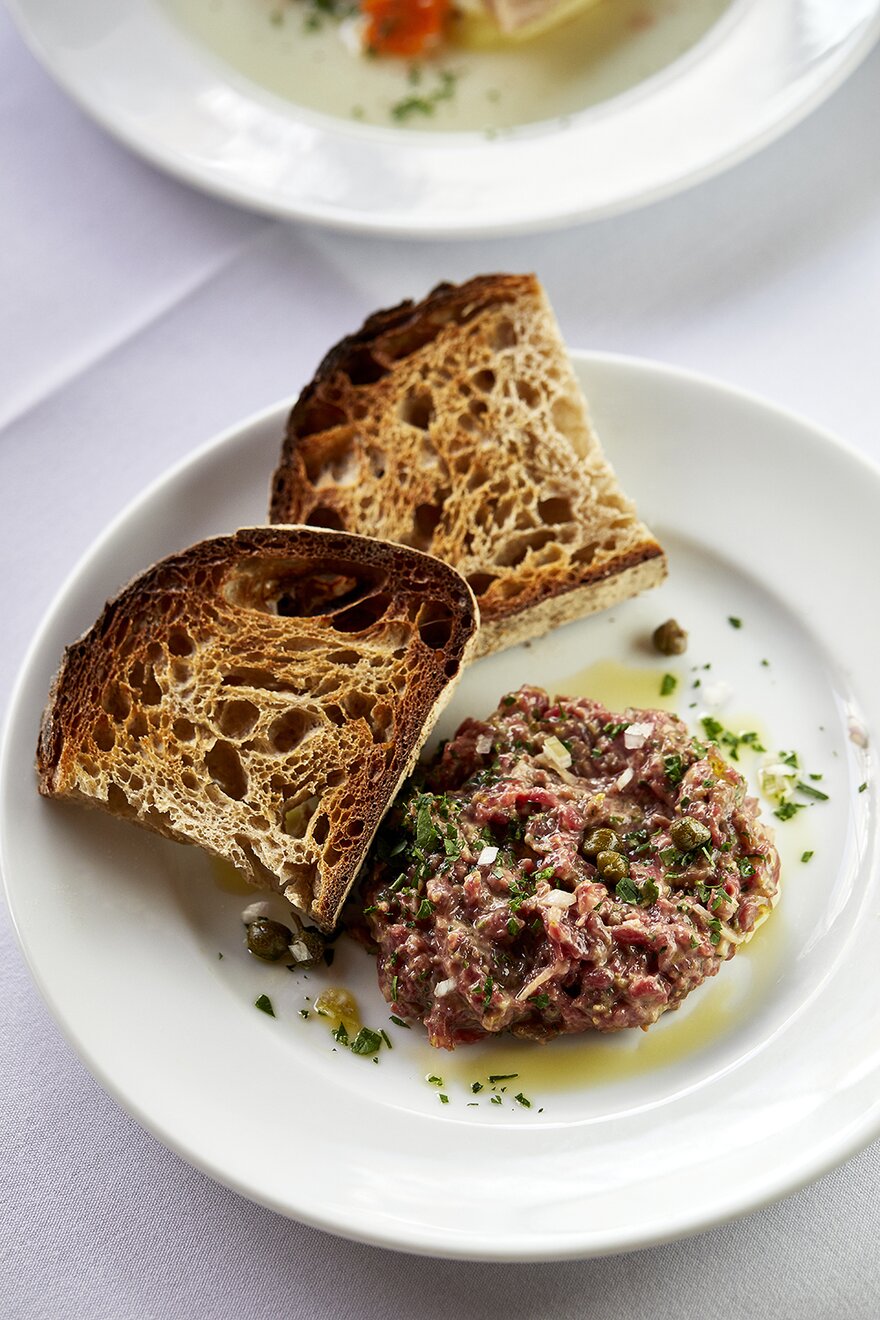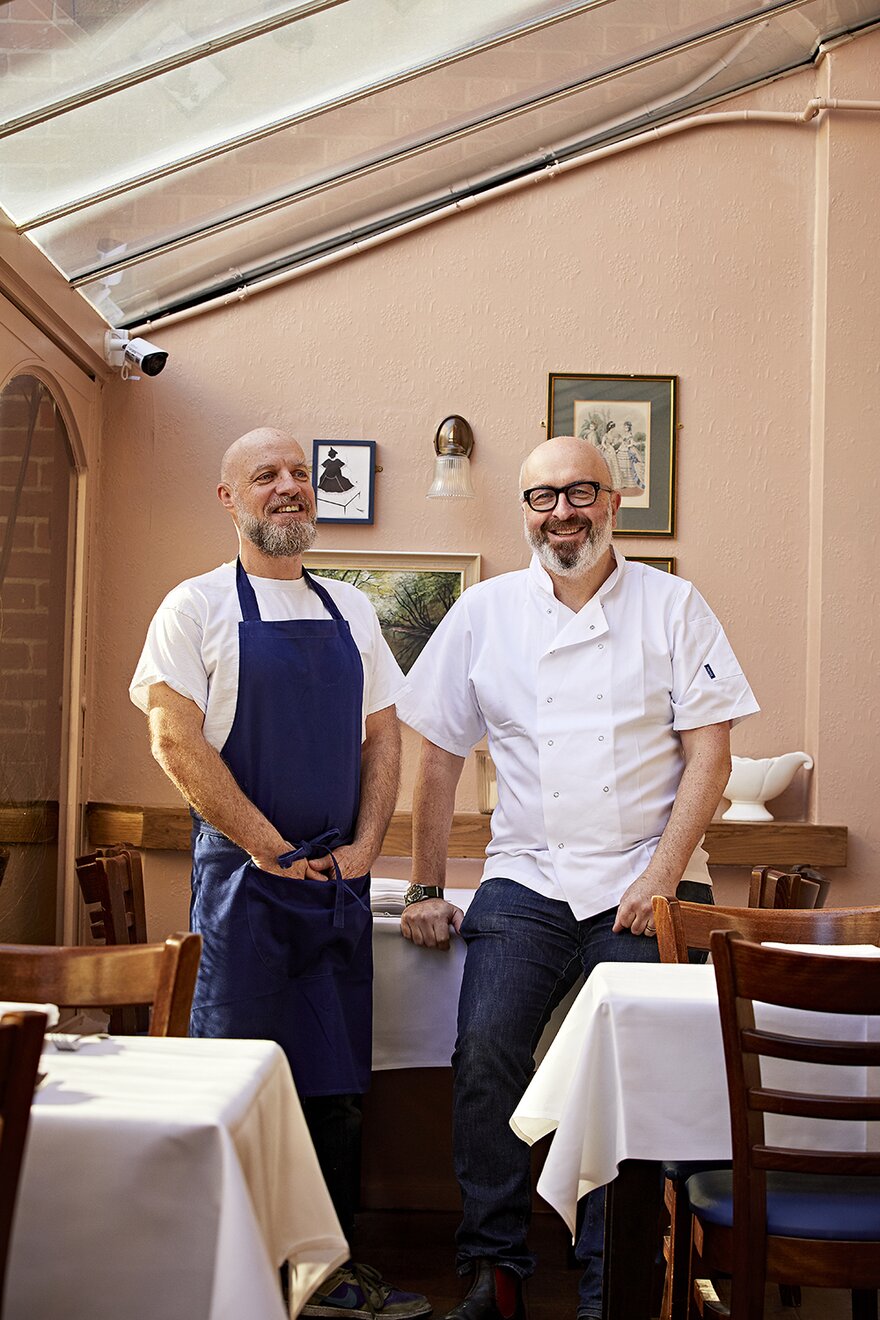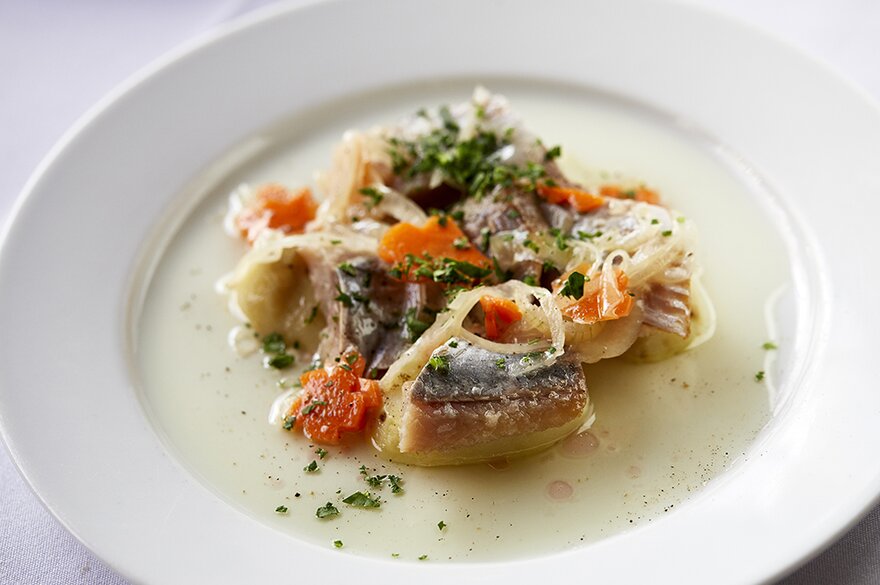After eight years, legendary Knightsbridge bistro Racine is reborn as Bouchon Racine in London's Farringdon. Owners Henry Harris and David Strauss tell why now was the right time for its return
It's 9am, 15 February, and co-owner and chef-patron Henry Harris is in the Bouchon Racine kitchen, prepping guinea fowl. Front of house, in the post date-night carnage, fellow owner Dave Strauss and head chef Chris Handley are frantically reassembling tables.
"If we'd realised you were doing this interview the day after Valentine's Day, we'd never have agreed," says Strauss, deadpan and low-key, like a diminutive Hell's Angel with his beard and shaved head. But then again, he admits, them's the breaks when you don't have a PR to advise you, or even a marketing budget. Because even though Bouchon Racine has been one of the most high-profile openings on the London dining scene over the past six months – launching to near-universal acclaim – it's also been arguably its most low-key: no Tatler-covered launch party, no high-profile designer flown in from abroad, not even the budget for matching crockery.
"New openings don't have to be a concept, they don't need a huge team of people, they don't need a massive marketing budget," says Strauss. "They need a lot of effort and hard work and people that care, and then you can produce something special."
Special is certainly what the "dribbling" (Jay Rayner's words) critics deem Bouchon Racine, the reincarnation of Harris's much-loved Knightsbridge restaurant Racine, which closed in 2015. Reborn as a 40-cover restaurant above the Three Compasses pub in Farringdon – which the couple are also operating – it's had the broadsheets in raptures for Harris's gutsy French bourgeois cooking (see panel), which includes dishes such as tête de veau (deboned, rolled and poached calf's head) with sauce ravigotte, veal chop with Roquefort butter, and rabbit with mustard sauce. In fact, so deep is the praise, that Harris – now coaxed out of the kitchen in his whites and apron – says it makes him a bit teary: "I've never had such good reviews for anything I've done. It's quite humbling. I get emotional at times."
Wait for it
It's fair to say some of the praise is a result of the pent-up demand for a Racine comeback. The former restaurant opened in 2002, following on from Harris's well-reviewed stints at Bibendum, as part of chef Simon Hopkinson's first brigade, then as head chef at London's Harvey Nicholls Fifth Floor. Racine swiftly became a Knightsbridge landmark before suffering at the hands of a rapidly changing neighbourhood, as long-standing businesses and residents moved out and foreign money flooded in, leaving huge swathes of the houses and flats as dormant investment vehicles.
Harris sold the site in 2015 with the plan to immediately reopen Racine elsewhere but found himself baulking at landlords' premiums. "I didn't mind paying money for a business that is trading and has a degree of profitability. But paying it to someone who hasn't made their business work just seemed like bailing them out," he says. Instead, he took on consultancy at the likes of London-based pub group Harcourt Inns and "discovered that it could be really lucrative".
Strauss, meanwhile, was busy helping launch Goodman Restaurants, which opened its first site in 2008. "I started as employee number one at Goodman. We did £5,000 in the first week. But when I left 10 years later, we turned over £77m [per year]." Openings included three Goodman steak restaurants, the international phenomenon Burger & Lobster and high-end steak and king crab restaurant Beast. "With that success comes frequent flyer miles, lounge access, corporate dining and good money. But after a while it becomes unfulfilling. It became obvious that I wasn't suited to working for large companies because I banged up against finance and marketing and other departments. I really enjoy working on the floor. And that's probably the only thing I'm really any good at."
Strauss parted ways with Goodman in 2018 and followed it with a brief stint at Mitch Tonks' Rockfish group. At the same time, Harris was beginning to feel a similar disconnect from the coal face. "The whole creative element of consultancy is incredibly enjoyable," says Harris. "But for me, it became slightly shallow in that you're not going to wake up at 4am worried about what's going to happen in the same way as you do when you run your own restaurant." As the pandemic eased, the ghost of Racine reappeared. "I got home from having dinner with friends one night and woke my wife and said: ‘I'm going to reopen Racine.' And she said: ‘About time'."
Strauss was on the market for a restaurant of his own and, after a mutual investor connected the two, the pair soon realised they shared common goals. "We were at an age where we've got probably one big project left in us and an enormous amount of experience," says Strauss.
All the pair needed was a site. Harris scoured Notting Hill, Holland Park, Primrose Hill, Maida Vale, Bloomsbury and beyond, but landed on Farringdon having fallen in love with the area while opening the Coach for Harcourt Inns. "It was a lightbulb moment: this is where it should be. Farringdon seems to be changing into such a vibrant area, especially with the Elizabeth line – how often do you see something happen in London that no one says anything negative about? To be part of it is absolutely fantastic," says Strauss.
The other epiphany Harris had while at Harcourt Inns was the viability of running a pub restaurant, with "two distinct revenue streams". So when Strauss called him about the Three Compasses pub opposite Farringdon station – a site that had been on the market for a year and which Harris had already dismissed – the couple took a second look.
"The pub was long and dark and we thought we could change that. Then we came upstairs and saw the glass terrace and thought it would make a nice little 40-cover restaurant," says Harris. "So we put a business plan together and realised we could make some money out of it."
By that time, the couple had attracted four investors keen to back them either together or separately – John Barnes (ex-La Tasca and Harry Ramsden), fishmonger Rex Goldsmith, Charlie Carroll of Flat Iron and Mike Lucy of Company of Cooks – "I don't think any of them hesitated," says Harris.
Match point
The budget to refurbish and kit out the site was minimal, so the pair called in some favours and were helped out by the likes of Bob Bob Ricard, Goodman and Boundary. "Nothing matches," says Strauss. "We would have loved to have had meetings about china and badging plates and napkins because that's a lovely part of opening a restaurant. But it is bullshit. We know it's bullshit because customers say to us: ‘Oh, it's lovely that none of the plates match!'"
Meanwhile, the pair had to be creative with the interiors. "If we'd started pulling stuff out it would have had to have been rewired and replumbed, so it had to be a facelift," he says. Strauss slept in the flat upstairs for a week to lead it, roping in as many favours as possible. Tonks lent him a couple of maintenance staff from Rockfish, and the team rolled up their sleeves and got to work.
"I don't think there's a bit of this room that I haven't painted," says Strauss. Having overseen six-figure restaurant refurbishments while at Goodman, what does he prefer – the big-budget makeovers or the low-cost, hands-on ones? "One of the things that I was always really, really upset about was the amount of money that was wasted on a build. Builders never hit a deadline. Whenever you walk in a restaurant site, there's always a tea-break going on because they're waiting for drywall or whatever. But I was living on-site and Henry was here every day, so we ran errands to keep them going. That's how you hit a build deadline! I would say we probably saved £200,000 just by doing a lot of things ourselves."
The result is a room that has a lived-in, almost ageless quality to it – pipes painted over, a daily changing menu chalked up on a couple of large blackboards, framed pictures from Racine's past like a family front room. "One industry member came in and said: ‘How did you manage to achieve the look of such an established restaurant when you have no design experience?' It looks like it's been here for years, but it looks well cared for and loved," says Harris.
Less is more
All of this provides an authentic backdrop for Harris's bourgeois French food – "restaurants in France get painted over and added to the whole time," he says. Diners will recognise many of the dishes from the old Racine, albeit with a heavier Lyonnais influence. The only other difference, he says, is that age and experience has taught him not to over-complicate dishes. "I'm going to be 60 this year, and I've learned that sometimes you need to put less on the plate. We did an egg mayonnaise with black Périgord truffle. We did it in three halves with the mayonnaise and the truffles on top and then a few chives. We could have added a salad or a drizzle of something, but I looked at it and said, why would you want to dilute that or distract from what it is? I find I'm pulling myself back more and more." In the kitchen, Racine's old head chef Chris Handley joins Harris overseeing a brigade of five.
Downstairs, the pub is a work in progress. It's tied to Star Pubs, which limits how much they can change, but in some ways that has turned out to be a blessing, says Strauss.
"Had we taken over a free house, Henry and I would have spent a month travelling around to little breweries finding beers that we liked. And, instead, that month we focused on the restaurant, making sure everything was ready. We sell lots of Moretti, Guinness and crisps and lots of beer that maybe we wouldn't normally do, and we focus on the things that are really important."
"It's a station pub," says Harris. "People want to walk in and buy something they recognise, not something really esoteric."
For two industry veterans desperate to reconnect with the part of the job they love, does anything beat being back on the floor and back on the pass? "Nothing," says Harris. And Strauss couldn't agree more: "Yesterday Henry was cooking a steak au poivre and it was like a work of art. And I was across the pass, just waiting for it to come so I could run it 15 feet out to the table, because I knew that would make all the difference. It's an absolute joy to carry that food out to those customers. And it's just lovely that people are enjoying it as much as I am serving it."
What the critics say
Jay Rayner, The Guardian
"I am a huge, dribbling admirer of all the people involved and all the food they serve… Bouchon Racine is everything."
Giles Coren, The Times
"It's not Racine all over again but Racine modernised, Racine 2.0 – the menu and mentality transferred to a working London district, a modern village, where the many workers who keep the Hatton Garden jewellery district afloat can come for pints at 6pm with a merguez baguette, office bosses can have a posh lunch, Barbican locals can do a proper dinner and old customers from SW3 can drop in and dream."
Tim Hayward, FT
"It's a funny room, up a flight of stairs that looks like something Guy Ritchie would have a gangster thrown down in a bad heist movie, with a rooftop conservatory of the sort someone sold your parents in the 1990s. The decor is wall-to-wall eBay tchotchkes, but selected by someone who got a Bafta for set design. An incredible effect. Just the right side of arch but good-natured, loving and overwhelmingly comforting. The dishes would have looked good in a Kodachrome taken some time in 1968; if you know me, you'll recognise that as a compliment. All of it was stunning."
Jimi Famurewa, Evening Standard
"I suppose sceptics could justifiably attribute this early hype to both Harris's popularity and French country cooking's particular comfort blanket cache among the food world's more influential figures. But I think there's more to it than that. At a time of brazen restaurant cynicism and fearful glances towards the future, Bouchon Racine is a sanely priced passion project that urges us to live, gloriously, in the moment. Every corner of it hums with soul, character and intention. And that, in any language, is worth its weight in gold."
From the menu
Escarole, tarragon, mimolette salad £8.50
Hareng, pomme a l'huile £10
Bayonne ham, celeriac rémoulade £12
Chicken liver pâté, cornichons £9.50
Orzo, wild mushrooms, herbs £17.50
Cod, piperade £29
Filet au poivre £48
Bavette, sauce Saint-Marcellin £24.50
Tarte Vaudoise a la crème £9
Rhubarb crème fraîche, salted praline £9
Mont blanc for two £18
Continue reading
You need to be a premium member to view this. Subscribe from just 99p per week.
Already subscribed? Log In








